New York City has more than earned its title as the Capital of the World, especially as a cultural epicenter. There are more than 170 museums in NYC, including one on rural farm life (yes, really) and cutting-edge, avant-garde art.
Whether you’re looking to see a planetarium show or want to spend an afternoon perusing one of the world’s largest art museums, there’s a museum for every kind of traveler. These are 10 must-visit museums in New York City.

An installation view of one of the galleries within the David Geffen Wing, “Transfigurations,” at the Museum of Modern Art.
Photo by Anton_Ivanov/Shutterstock
1. The Museum of Modern Art
- Location: 11 W. 53rd St. | Find on Google Maps
- Hours: Sunday–Thursday 10:30 a.m.–5:30 p.m., and Saturday from 10:30 a.m.–7 p.m.
- Admission: $30 per person
Would any trip to New York City be complete without a visit to the Museum of Modern Art? Located in Midtown Manhattan, MoMA was the first museum in the city devoted to modern art and is now one of the largest and most well-known cultural institutions of its kind in the world. Today, the museum has more than 150,000 pieces in its collection, including works like Andy Warhol’s Campbell’s Soup Cans, Vincent van Gogh’s The Starry Night, self-portraits by Frida Kahlo, and photographs by Cindy Sherman. The museum also has an extensive film collection with 30,000 films and 1.5 million film stills; it regularly hosts on-site screenings, which are often paired with talks led by high-wattage directors and stars. Rest your feet after hours of standing in galleries in the museum’s tranquil courtyard, complete with a burbling fountain. The gift shop is one of the best places in the city for design-focused home goods.

The Egyptian Temple of Dendur at the Metropolitan Museum of Art
Photo by Maurizio De Mattei/Shutterstock
2. The Metropolitan Museum of Art
- Location: 1000 Fifth Ave. | Find on Google Maps
- Hours: Sunday–Tuesday and Thursday 10 a.m.–5 p.m., Friday and Saturday 10 a.m.–9 p.m.
- Admission: New York residents pay what they wish, nonresidents pay $30
Enter New York City’s art titan: The Metropolitan Museum of Art is the most visited museum in NYC and the largest art museum in the Western Hemisphere. The Met has more than 1.5 million pieces of art in its collection, spanning thousands of years. There are prehistory artifacts, paintings by the Old Masters, and works by modern artists like Mary Sully. The Met also boasts a healthy roster of rotating exhibitions, a wing devoted to Islamic art, and the Costume Institute, which kicks off its yearly exhibition by throwing the annual Met Gala. And with its memorable architecture—think grand windows, Gothic revival-style embellishments, and those iconic steps—a trip to the Met just to see the building alone is worthwhile. Don’t miss the rooftop, which has a seasonal bar, sculpture installations, and wraparound views of Central Park. The museum also has a second location, the Met Cloisters, which features medieval art and is in the upper Manhattan neighborhood Washington Heights.
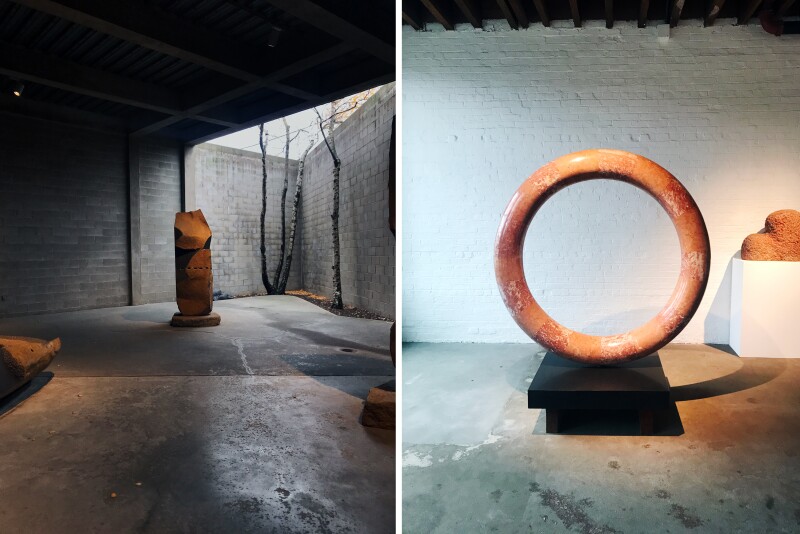
The Noguchi Museum in Brooklyn was designed by Noguchi himself.
Photos by Michelle Heimerman
3. The Noguchi Museum
- Location: 9-01 33rd Rd., Queens | Find on Google Maps
- Hours: Wednesday–Sunday 11 a.m.–6 p.m.
- Admission: $16 per person; free the first Friday of every month
Born in New York City in 1904 to an Irish American mother and Japanese father, Isamu Noguchi was one of the most influential sculptors of the past century. Although he worked with materials including marble, stainless steel, and cast iron, he’s probably best known for his Noguchi tables, which are characterized by their curvaceous bases made from carved wood and their freeform glass tops, as well as his Akari light sculptures (washi paper and bamboo lamps now synonymous with modern design). The Noguchi Museum in Long Island City was designed and built by Noguchi himself. Here, visitors will find his abstract sculptures spread across 27,000 square feet of serene exhibition space. Check out the outdoor sculpture garden, which is inspired by traditional Japanese garden layouts—it’s the perfect place to catch a quiet moment of reflection in the city.

Outside the Brooklyn Museum is Deborah Kass’s OY/YO sculpture.
Photo by Enrico Della Pietra/Shutterstock
4. Brooklyn Museum
- Location: 200 Eastern Pkwy., Brooklyn | Find on Google Maps
- Hours: Wednesday–Sunday 11 a.m.–6 p.m.; First Saturday in February–June, August, and October until 11 p.m.
- Admission: $20 per person; $25 for special exhibitions; free first Saturday of the month (see above)
Founded in 1898, the Brooklyn Museum is located in an 1897 Beaux-Arts-style building and rivals Manhattan’s Met in its historic collection and late-night events. The collection here spans 3,000 years, and much like the Met, it offers a little from every period of human history. Visitors will find galleries devoted to African art, ancient Egyptian artifacts (one of the largest collections of its kind in the USA), as well as contemporary art, with modern and often edgy exhibitions featuring the works of famous contemporary names, like Spike Lee and David Bowie. Another highlight is The Dinner Party by Judy Chicago, a unique work of feminist art created during the 1970s. It pays homage to powerful women throughout history.
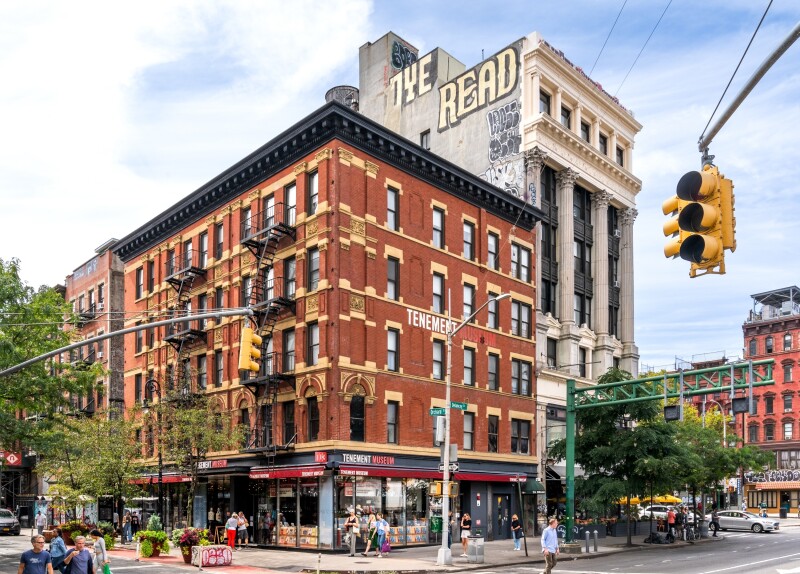
The Tenement Museum focuses on the city’s rough-and-tumble immigrant past.
Photo by Brian Logan Photography/Shutterstock
5. The Tenement Museum
- Location: 103 Orchard St.| Find on Google Maps
- Hours: Sunday–Thursday 10 a.m.–5:30 p.m.; Friday and Saturday until 6 p.m.
- Admission: $30 per person
While the Lower East Side is now a trendy place filled with chic bars, restaurants, and hotels, it was once the most densely populated place in all of Manhattan—packed with tenement buildings where immigrants lived and worked in cramped apartments shared by multiple families. At the Tenement Museum, which focuses on the years between 1869 to 1935, visitors can get a taste of what life was like for immigrants who came to New York City seeking a better life. The Tenement Museum spans two restored tenement buildings from the 19th century that once housed 15,000 people. The museum experience includes walking tours and restored, period-accurate rooms.

The Museum of Natural History’s iconic and enormous blue whale weighs 21,000 pounds.
Photo by Chris Ford/Flickr
6. American Museum of Natural History
- Location: 200 Central Park West | Find on Google Maps
- Hours: Every day 10 a.m.–5:30 p.m.
- Admission: New York residents pay what they wish, nonresidents pay $30
The American Museum of Natural History (AMNH), located directly across from Central Park, is one of the most iconic museums in the city, if not the world. There are more than 30 million specimens here, and the scope of its exhibitions is nothing if not ambitious: The museum’s focus spans from the Big Bang to the present day. It would be easy to spend a full day at the AMNH. Highlights include the 94-foot-long blue whale replica in the Milstein Hall of Ocean Life, an enormous collection of taxidermied animals, tons of dinosaur artifacts, the Hayden Planetarium (currently directed by astrophysicist celebrity Neil deGrasse Tyson), and the Richard Gilder Center for Science, Education, and Innovation, which opened in May 2023 and has an insectarium, including a live butterfly exhibition, on display.
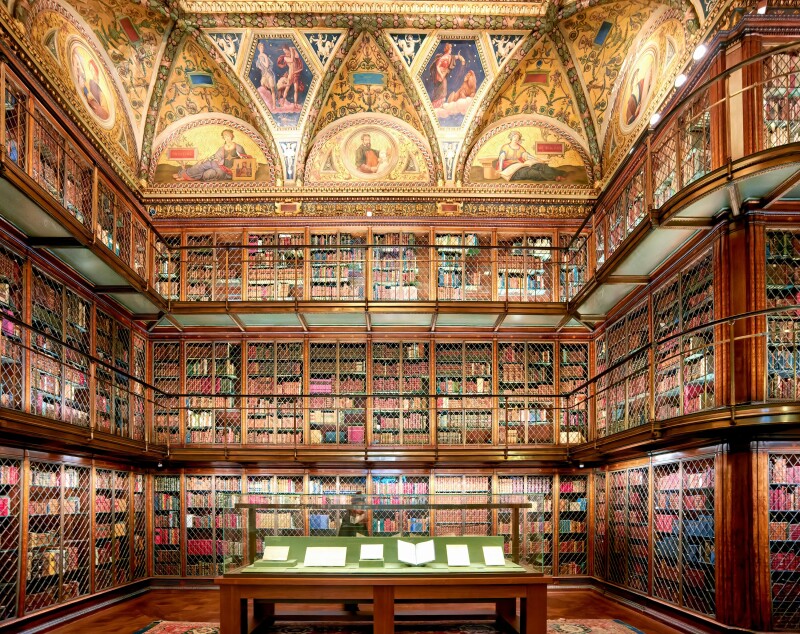
At the Morgan Library & Museum, you can take a look at the institution’s collection of literary manuscripts, printed books, and drawings.
Photo by Marco Brivio Photography/Shutterstock
7. The Morgan Library & Museum
- Location: 225 Madison Ave. | Find on Google Maps
- Hours: Tuesday–Sunday 10:30 a.m.–5 p.m.
- Admission: $25 per person; admission to the library’s historic rooms is free Tuesday and Sunday 3–5 p.m.; the museum itself is free Fridays 5-7 p.m. (reservations required)
Who can resist a good library, especially one as ornate as the Morgan Library & Museum? The Morgan Library was initially constructed in 1906 to house the books of banker J.P. Morgan (yes, that J.P. Morgan). Soon after he died in 1924, his son opened the building to the public, per his father’s will. Today the complex includes the library, an annex, a garden court, and a beautiful glass structure designed by Pritzker Prize–winning architect Renzo Piano in 2006 that connects it all together. Inside, guests will find an ornate interior decorated with murals and plasterwork inspired by the Italian High Renaissance artist and architect Raphael. The library’s extensive collection of rare books and manuscripts includes annotated and autographed musical scores by Beethoven, Brahms, and Chopin; three Gutenberg Bibles; illuminated manuscripts; and letters that date to ancient Babylon. The property also includes an annex building (constructed in 1928) on the corner of Madison Avenue and 36th Street as well as Morgan senior’s former residence, a handsome mid-19th-century brownstone.
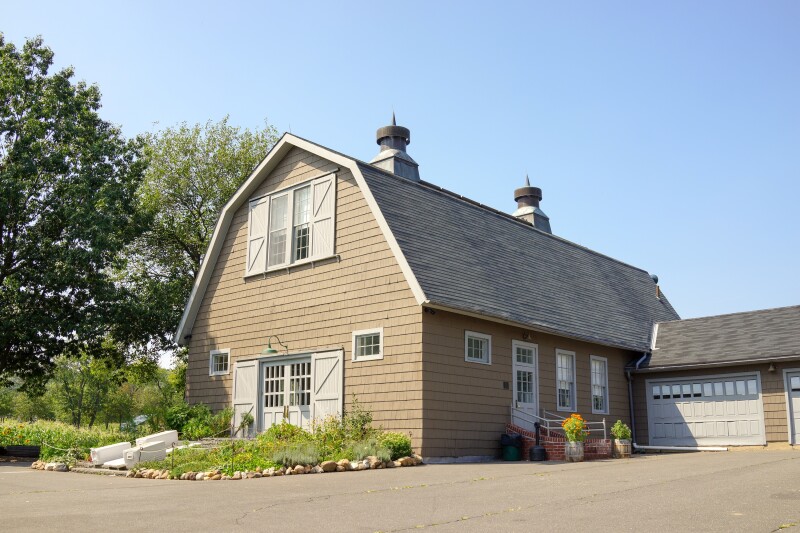
The land on Queens County Farm Museum has been continuously farmed for more than 300 years.
Photo by Alan Tan Photography/Shutterstock
8. Queens County Farm Museum
- Location: 73-50 Little Neck Pkwy., Queens | Find on Google Maps
- Hours: Every day 10 a.m.–5 p.m.
- Admission: Free except on special admission days
If you’re looking to get away from the busy city for a moment, consider visiting the Queens County Farm Museum. Situated on 47 idyllic acres in Queens’ Floral Park neighborhood, the museum is the city’s largest remaining tract of undisturbed farmland and is one of the oldest continuously farmed and cultivated tracts in the state of New York—it’s been worked for more than 300 years. These days, more than 200 varieties of crops grow at the Queens County Farm Museum, and animals such as sheep, goats, alpacas, and chickens live on the property. There are also several replica historic buildings and vintage farm equipment for guests to explore. Hayrides are available ($6 per person), and the museum hosts a healthy roster of seasonal events such as the annual holiday market.
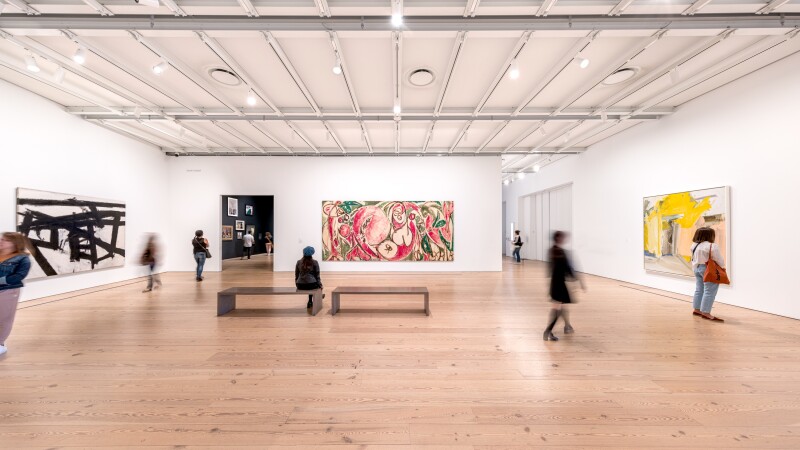
The Whitney’s permanent collection includes paintings from 1900 to the 2020s.
Courtesy of Max Touhey/Whitney Museum of American Art
9. The Whitney Museum of American Art
- Location: 99 Gansevoort St. | Find on Google Maps
- Hours: Saturday–Thursday 10:30 a.m.–6 p.m., Friday 10:30 a.m.–10 p.m., closed on Tuesdays
- Admission: $30 per person; Free Fridays 5–10 p.m. and second Sunday of each month (reservations required)
In 2015, the 92-year-old Whitney Museum of American Art (aka the Whitney) moved into a futuristic then-new building designed by Renzo Piano in the Meatpacking District. The 63,000-square-foot construction offers visitors sweeping views of the nearby Hudson and the High Line and has four outdoor exhibition spaces. Best known for its collection of American art, the Whitney has some 26,000 works by modern artists such as Georgia O’Keeffe, Mark Rothko, Jean-Michel Basquiat, and Kara Walker, and for its focus on artists who identify as BIPOC. The Whitney Biennial, one of the museum’s biggest events, is an ambitious survey show of work in all media occurring over the previous two years.

The Guggenheim’s design is as famous as the art it contains.
Courtesy of Reno Laithienne/Unsplash
10. The Solomon R. Guggenheim Museum
- Location: 1071 Fifth Ave. | Find on Google Maps
- Hours: Sunday–Friday 11 a.m.–6 p.m., Saturday 11 a.m.–8 p.m.
- Admission: $30 per person; pay-what-you-wish Mondays and Saturdays 4–5:30 p.m. (reservations recommended)
Designed by Frank Lloyd Wright and opened in 1939, the Solomon R. Guggenheim Museum is perhaps one of the most architecturally interesting cultural institutions in the world—so much so that it was awarded UNESCO World Heritage site status in 2019. The Guggenheim is not a rectangle—instead, it has a cylindrical shape. Rather than moving from boxy gallery to gallery, guests spiral up the museum’s “floors,” allowing them to view the Guggenheim’s works in a continuous loop. Visitors will find 7,000 pieces at the museum, ranging from art created by Pablo Picasso to Vassily Kandinsky.
This article was originally published in 2023 and most recently updated on September 17, 2024, with current information.











